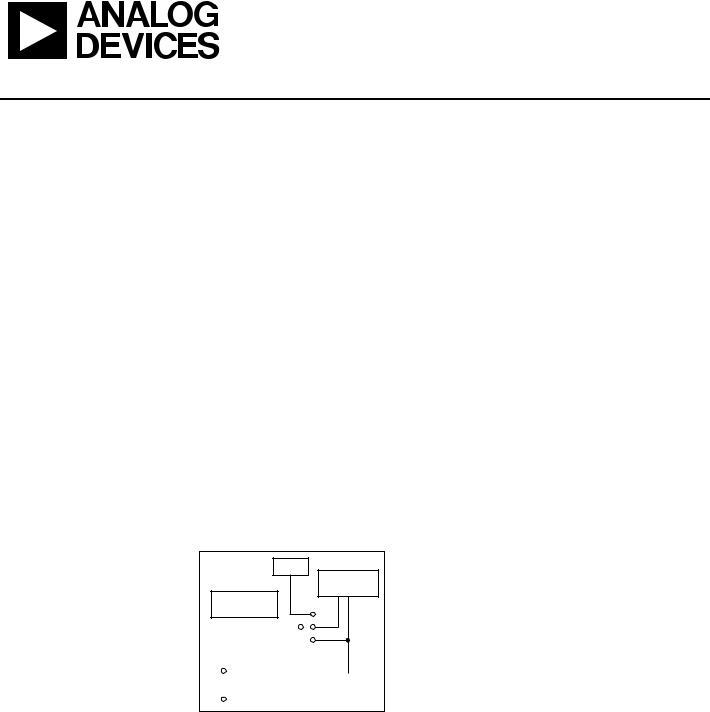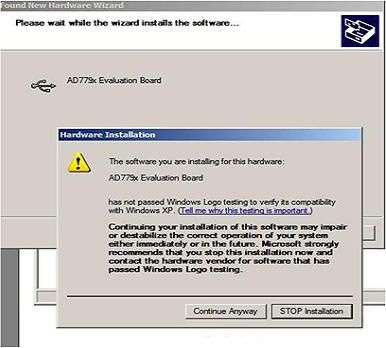ANALOG DEVICES UG-079 Service Manual

Evaluation Board User Guide
UG-079
One Technology Way • P.O. Box 9106 • Norwood, MA 02062-9106, U.S.A. • Tel: 781.329.4700 • Fax: 781.461.3113 • www.analog.com
Evaluation Board for the AD7781 20-Bit, Pin-Programmable,
Low Power, Sigma-Delta ADC
FEATURES
Full-featured evaluation board for the AD7781 Standalone USB interface
Various linking options
PC software for control of AD7781
GENERAL DESCRIPTION
This user guide describes the evaluation board for the AD7781, which is a pin programmable, low power, 20-bit sigma-delta (Σ-Δ) ADC. The AD7781 is a complete analog front end for low frequency measurement applications such as bridge sensor systems. It contains one differential input and includes a low noise instrumentation amplifier. The output data rate can be programmed to 10 Hz or 16.7 Hz. The AD7781 also has an on-board clock, eliminating the need for an external clock. It employs a Σ- conversion technique to realize up to 20 bits
of no missing codes performance. The input signal is applied to an analog modulator. The modulator output is processed by
an on-chip digital filter. The analog input channel of the AD7781 accepts analog input signals of ±VREF or ±VREF/128. With the update rate programmed to 10 Hz, the rms noise is 44 nV when the gain is 128. Simultaneous 50 Hz/60 Hz rejection is available at both output data rates.
Full data on the AD7781 is available in the AD7781 data sheet available from Analog Devices, Inc., and should be consulted in conjunction with this user guide when using the evaluation board.
The evaluation board interfaces to the USB port of an IBMcompatible PC. Software is available with the evaluation board that allows users to easily communicate with the AD7781.
Note that the AD7781 evaluation board software should be installed before connecting the AD7781 evaluation board to the PC.
Another component on the AD7781 evaluation board is the ADP3303 high precision, low power, 3.3 V output voltage regulator, which is used to power the USB/SPI interface.
FUNCTIONAL BLOCK DIAGRAM
AVDD
VOLTAGE
REGULATOR
LOADCELL
CONNECTOR
|
|
|
|
|
|
|
USB |
|
|
|
|
|
|
|
|
|
PC AND |
||
ANALOG |
AD7781 |
|
SPI/USB |
CONNECTOR |
|
LabVIEW™ |
|||
INPUTS |
|
INTERFACE |
|
|
BASED |
||||
|
|
|
|
|
|
|
|
|
SOFTWARE |
|
|
|
|
|
|
|
|
|
|
|
|
|
|
|
|
|
|
|
|
Figure 1.
08749-001
PLEASE SEE THE LAST PAGE FOR AN IMPORTANT |
|
WARNING AND LEGAL TERMS AND CONDITIONS. |
Rev. 0 | Page 1 of 16 |
UG-079 |
Evaluation Board User Guide |
|
|
TABLE OF CONTENTS |
|
Features .............................................................................................. |
1 |
General Description ......................................................................... |
1 |
Functional Block Diagram .............................................................. |
1 |
Revision History ............................................................................... |
2 |
Evaluation Board Hardware............................................................ |
3 |
Power Supplies .............................................................................. |
3 |
Links............................................................................................... |
3 |
Setup Conditions .......................................................................... |
4 |
Sockets ........................................................................................... |
4 |
Interfacing to the Evaluation Board........................................... |
5 |
REVISION HISTORY
2/10—Revision 0: Initial Version
Evaluation Board Software............................................................... |
6 |
Software Description .................................................................... |
6 |
Installing the Software .................................................................. |
6 |
Using the Software ........................................................................ |
6 |
Main Window ................................................................................ |
7 |
Weighscale Demo Window.......................................................... |
8 |
Evaluation Board Schematic and Artwork..................................... |
9 |
Ordering Information.................................................................... |
13 |
Bill of Materials........................................................................... |
13 |
Rev. 0 | Page 2 of 16

Evaluation Board User Guide |
UG-079 |
|
|
EVALUATION BOARD HARDWARE
POWER SUPPLIES
The AD7781 evaluation board is powered via the 5 V supply from the USB connector, J1. This 5 V supply can be used to power the AD7781 directly. A 3.3 V regulated voltage from the on-board ADP3303 (a high precision, low power, 3.3 V output voltage regulator) can also be used. Alternatively, the AD7781 can be powered using an external 3 V or 5 V power supply via J2.
Table 1. Evaluation Board Link Settings
LINKS
There are sixteen groups of link options that must be set for the required operating setup before using the evaluation board. The functions of these link options are outlined in Table 1.
Link |
Default |
LK1, LK2 |
In |
LK3, LK4 |
In |
LK5 |
3.3 V |
LK6 to LK11 |
In |
LK12, LK13, LK14 |
In |
LK15 |
10 Hz |
LK16 |
128 |
Description
These links are used to connect the AIN(+) and AIN(−) inputs to AVDD/2. With this configuration, a noise analysis can be performed. With these links removed, an external voltage may be applied to AIN(+)/AIN(−) using the SMB connectors.
With LK3 and LK4 in place, AVDD is used as the reference to the AD7781. REFIN(+) is connected to AVDD and REFIN(−) is connected to GND. To use another reference source, remove LK3 and LK4.
LK5 is used to select the power source for AVDD on the AD7781.
In Position A, LK5 selects an external power supply, supplied via J2.
In Position B, LK5 selects the 3.3 V regulated output from the on-board ADP3303 voltage regulator. In Position C, LK5 selects the 5 V supply from the USB connector, J1.
These links connect the serial interface pins of the AD7781 to the SPI interface of the microcontroller. The links should be in place to use the AD7781 evaluation board software. With these links removed, the AD7781 can be interfaced to an external microcontroller.
These links are used for the bridge power-down switch. With LK12 inserted, the bridge power-down switch is connected to AVDD through an LED. When the bridge power-down switch is closed, the LED turns on. LK13 should be open when LK12 is inserted.
LK13 and LK14 are used when a load cell is connected to Header J4. LK12 should be left open. With LK13 inserted, the bridge power-down switch is connected to Header J4. The low side of the load cell can be connected to GND through the bridge power-down switch. With LK14 inserted, the low side of the load cell is connected directly to GND. The terminal REFIN(−) should be shorted to the GND/PSW terminal on Header J4 to enable the previous functions.
LK15 is used to select the output data rate for the AD7781. With LK15 in Position 10 Hz, the output data rate is set to 10 Hz. When LK15 is in Position 16.7 Hz, the output data rate is set to 16.7 Hz.
LK16 is used to select the gain of the AD7781. With LK16 in Position 1, the gain is set to 1. With LK16 in Position 128, the gain of the AD7781 is set to 128.
Rev. 0 | Page 3 of 16

UG-079 |
Evaluation Board User Guide |
|
|
SETUP CONDITIONS
Take care before applying power and signals to the evaluation board to ensure that all link positions are set per the required operating mode. Table 2 shows the position in which all the links are initially set.
Table 2. Initial Links and Positions
SOCKETS
There are five sockets relevant to the operation of the AD7781 on this evaluation board. The functions of these sockets are outlined in Table 3.
Link No. |
Position |
LK1, LK2 |
In |
LK3, LK4 |
In |
LK5 |
B |
LK6 to LK11 |
In |
LK12 |
In |
LK13 |
Out |
LK14 |
In |
|
|
Function
AIN(+) and AIN(−) are shorted to AVDD/2. The reference voltage is set to 3.3 V (AVDD).
The 3.3 V supply is used as AVDD for the AD7781.
The AD7781 is interfaced to the on-board microcontroller. The bridge power-down switch is connected to AVDD.
The bridge power-down switch is disconnected from Header J4. Terminal GND/PSW of Header J4 is connected to GND.
Table 3. Socket Functions
Socket |
Description |
|
|
AIN+ |
Subminiature BNC (SMB) connector. The analog input signal for the AIN(+) input of the AD7781 is applied to this socket. |
AIN− |
Subminiature BNC (SMB) connector. The analog input signal for the AIN(−) input of the AD7781 is applied to this socket. |
REFIN+ |
Subminiature BNC (SMB) connector. This socket is used in conjunction with REFIN− to apply an external reference to the AD7781. |
|
The voltage for the REFIN(+) input of the AD7781 is applied to this socket. |
REFIN− |
Subminiature BNC (SMB) connector. This socket is used in conjunction with REFIN+ to apply an external reference to the AD7781. |
|
The voltage for the REFIN(−) input of the AD7781 is applied to this socket. |
J4 |
6-pin terminal block. This is used to connect an external load cell to the AD7781 evaluation board. |
|
|
Rev. 0 | Page 4 of 16

Evaluation Board User Guide |
UG-079 |
|
|
INTERFACING TO THE EVALUATION BOARD
Interface to the evaluation board is via a standard USB connector, J1. J1 is used to connect the evaluation board to the USB port of a PC. A standard USB connector cable is included with the AD7781 evaluation board to allow the evaluation board to interface with the USB port of the PC. Because the board is powered via the USB connector, there
is no need for an external power supply, although if preferred, one may be connected via J2.
Communication between the AD7781 and the PC is via the USB/SPI interface. The on-board USB controller (U2) handles this communication.
To set up the USB/SPI interface, use the following procedure:
1.Install the AD7781 evaluation board software using the supplied AD7781 evaluation board CD before connecting the board to the PC.
2.After the AD7781 evaluation board software is installed, connect the board to the PC via J1 on the AD7781 evaluation board and via the USB port on the PC using the supplied USB connector cable. The PC automatically finds the new USB device and identifies it as the AD779x Evaluation Board.
3.Follow the on-screen instructions that appear. During the installation process if the Hardware Installation Wizard appears as shown in Figure 2, click Continue Anyway
to successfully complete the installation of the AD7781 evaluation board.
08749-002
Figure 2. Hardware Installation Window
Rev. 0 | Page 5 of 16
